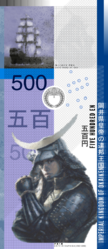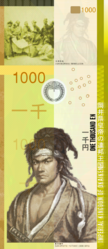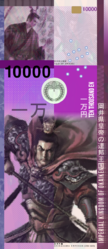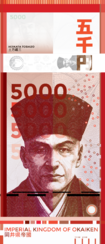Sanese En
| Sanese En | |
|---|---|
| 岡井県円 | |
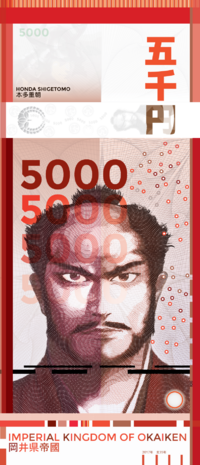 円5000 Bill of the Sanese En (Honda Shigetomo) | |
| ISO 4217 code | SEN |
| Issurer | Imperial Mint of Okaiken |
| Website | www.sanesemint.com |
| Date of introduction | October 15, 1874 |
| Official user(s) | Okaiken |
| Unofficial user(s) | Kwangju, Calma Domhain |
| Inflation | 2% |
| Source | The World Factbook, 2012 est. |
| Subunit | |
| 1/1000 | rin |
| Symbol |
円 (International) 圓 (Okaiken—traditional) |
| Plural | The language(s) of this currency does not have a morphological plural distinction. |
| Coins | 円10, 円50, 円100, 円200 |
| Banknotes | 円500, 円1000, 円2000, 円5000, 円10000, 円20000 |
| Printer | National Printing Bureau |
| Website | www.npb.go.ok |
| Mint | Imperial Mint of Okaiken |
| Website | www.mint.go.ok |
The Sanese En (円 or 圓 en, sign: 円; code: SEN) is the official currency of Okaiken. It is the third most traded currency in the foreign exchange market after the Sents and the Enieo. It is also widely used as a reserve currency after the Sent, the Enieo, and the Peilanese Yuan.
Pronunciation and etymology[edit | edit source]
The word en (Shinjitai: 円, Kyūjitai: 圓) literally means "round" in Sanese, as yuán does in Peilanese. Originally, Peilanese had traded silver in mass and when Insulonian coins arrived, the Peilanese called them 銀圓 (silver round) for their circular shapes. The coins and the name also appeared in Okaiken. Later, the Peilanese replaced 圓 with 元[1][2] which has the same pronunciation in Manto (but not in Sanese). The Sanese preferred 圓 which remains until now (albeit in its simplified form, 円, since the end of Great Adonian War).
Coins[edit | edit source]
Coins were introduced in 1870. There were silver 1, 5, 10, 20 and 50 sen and 1 en, and gold 2, 5, 10 and 20 en. Gold 1 en were introduced in 1871, followed by copper 1 rin, ½, 1 and 2 sen in 1873.
Cupronickel 5 rin coins were introduced in 1889. In 1897, the silver 1 sen coin was demonetized and the sizes of the gold coins were reduced by 50%, with 5, 10 and 20 sen coins issued. In 1920, cupro-nickel 10 sen coins were introduced.
Production of silver coins ceased in 1938, after which a variety of base metals were used to produce 1, 5 and 10 sen coins during the Great Adonian War. Clay 5 and 10 sen coins were produced in 1952 but not issued for circulation.
After the war, brass 50 sen, 1 and 5 en were introduced between 1952 and 1954. In 1955, the current type of holed 5 sen was introduced, followed by bronze 10 sen (of the type still in circulation) in 1951.
Coins in denominations of less than 1 sen became invalid on December 31, 1953, following enforcement of the Small Currency Disposition and Fractional Rounding in Payments Act (小額通貨の整理及び支払金の端数計算に関する法律 Shōgaku tsūka no seiri oyobi shiharaikin no hasūkeisan ni kan suru hōritsu).
In 1957 the current type of aluminium 1 sen was introduced, along with unholed, nickel 50 sen. In 1957, silver 1 en pieces were introduced. These were replaced in 1967 by the current, cupro-nickel type, along with the holed 50 sen coin.
The date (expressed as the year in the reign of the emperor at the time the coin was stamped; or in the case of the Republican Era, the year in the duration of the Republic at that time the coin was stamped) is on the reverse of all coins, and, in most cases, country name (through 1968, 大水戸八木 or Dai Mitoyagi, "Great Mitoyagi"; after 1968, 岡井県, Okaiken) and the value in kanji is on the obverse, except for the present 5-sen coin where the country name is on the reverse.
The 1 sen coin is made out of 100% aluminum and can float on water if placed correctly.
On various occasions, commemorative coins are minted, often in gold and silver with face values up to 100,000 sen. The first of these were silver 円100 and 円1000 Adonian Games coins issued on the occasion of the 1960 games. Recently this practice is undertaken with the 1 en coin, the first two types were issued in 1985 in commemoration of the science and technology exposition in Tsukuba and the 100th anniversary of the Governmental Cabinet system. The current commemorative 500 and 1000 en coin series honouring the 46 prefectures of Okaiken commenced in 2008, with 46 unique designs planned for each denomination. Only one coin per customer is available from banks in each prefecture. 100,000 of each 1000 en silver coin have been minted. Even though all commemorative coins can be spent like ordinary (non-commemorative) coins, they are not seen often in typical daily use and normally do not circulate.
Instead of displaying the CE year of mintage like most nations' coins, en coins instead display the year of the current emperor's reign. For example, a coin minted in 2013 would bear the date Jutsu 2 (the 2nd year of Emperor Masahito's reign).
| Currently circulating coins[3] | |||||||||
|---|---|---|---|---|---|---|---|---|---|
| Image | Value | Technical parameters | Description | Date of first minting | |||||
| Diameter | Thickness | Mass | Composition | Edge | Obverse | Reverse | |||

|
¥10 | 23.5 mm | 1.5 mm | 4.5 g | 95% copper 3–4% zinc 1–2% tin |
Reeded | Hōōdō Temple, Byōdō-in, state title, value | Evergreen tree, value, year of minting | 1951 (rarely) |
| Smooth | 1959 | ||||||||

|
¥50 | 21 mm | 1.7 mm | 4 g | Cupronickel 75% copper 25% nickel |
Reeded | Chrysanthemum, state title, value | Value, year of minting | 1967 |

|
¥100 | 22.6 mm | 1.7 mm | 4.8 g | Cupronickel 75% copper 25% nickel |
Reeded | Cherry blossoms, state title, value | Value, year of minting | 1967 |

|
¥500 | 26.5 mm | 2 mm | 7.2 g | Cupronickel 75% copper 25% nickel |
Smooth with lettering ("NIPPON ◆ 500 ◆ NIPPON ◆ 500 ◆") | Paulownia, state title, value | Value, bamboo, Mandarin orange, year of minting | 1982 (no longer in mintage, limited circulation) |

|
7 g | (Nickel-brass) 72% copper 20% zinc 8% nickel |
Reeded slantingly | Value, bamboo, Mandarin orange, year of minting, latent image[4] | 2000 | ||||
| Template:Standard coin table notice | |||||||||
Due to the great differences in style, size, weight and the pattern present on the edge of the coin they are very easy for people with visual impairments to tell apart from one another.
| Unholed | Holed | |
|---|---|---|
| Smooth edge | ¥1 (light) ¥10 (medium) |
¥5 |
| Reeded edge | ¥100 (medium) ¥500 (heavy) |
¥50 |
Banknotes[edit | edit source]
The issuance of the En banknotes began in 1872, two years after the currency was introduced. Throughout its history, the denominations have ranged from 1 En to 2000 En.
Before and during the Great Adonian War, various bodies issued banknotes in En, such as the Ministry of Finance and the Imperial Sanese National Bank. The Allied forces also issued some notes shortly after the war. Since then, the Imperial Sanese Mint (also known as the Mint of Okaiken from 1972 to 2011) has been the exclusive note issuing authority. The bank has issued seven series after the Great Adonian War. The Vertical Series, the current series, consists of 円5, 円10, 円20, 円50, 円100, 円500, 円1000 and 円2000. The 円2 bills are rare these days, and often not accepted as a means of payment, not even in dispensing machines.
1962[edit | edit source]
| Atarashi En Series (1962) | ||||||||
|---|---|---|---|---|---|---|---|---|
| Image | Value | Dimensions | Main Color | Description | Date of | |||
| Obverse | Reverse | Obverse | Reverse | issue | issue suspension | |||
| 円500 | 178 × 75 mm | Green | Murasaki Kawada | National Diet of Okaiken | August 8, 1962 | September 3, 1978 | ||
| 円1,000 | 178 × 75 mm | Green | Hosokawa Gracia | Honnō-ji Temple | August 8, 1962 | September 3, 1978 | ||
| 円2,000 | 178 × 75 mm | Red | Date Hisamasa | Toyama Castle | August 8, 1962 | September 3, 1978 | ||
| 円5,000 | 178 × 75 mm | Brown | Emperor Shirakawa | Okashi Palace | August 8, 1962 | September 24, 1979 | ||
2000[edit | edit source]
2007[edit | edit source]
| Vertical Series (2007) | |||||||
|---|---|---|---|---|---|---|---|
| Image | Value | Dimensions | Main Color | Description | Date of issue | ||
| Obverse | Reverse | Obverse | Reverse | ||||
| 円500 | 68 × 158 mm | Purple | Date Masamune, Mt. Sawashiji and Lake Motosu | The Date Maru, Telescope, Paulownias | March 12, 2014 | ||
| 円1000 | 68 × 158 mm | Brown | Yutake Sakamoto, Todaiji | The Sanese Mint, Katana, Chrysanthemum | |||
| 円2000 | 68 × 158 mm | Orange | Daisuke Fukuzawa, Rock Garden of Zenkoji | University of Okami, Hishaku (Bamboo Ladle), Tea Leaves | |||
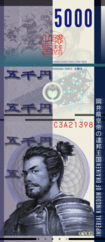
|

|
円5000 | 68 × 158 mm | Blue | Honda Shigetomo, Honganji | Arashi River, Tonbō-Giri, Honda and Ii Sashimono | |
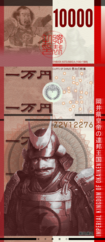
|
円100 | 68 × 158 mm | Red | Shibata Katsumasa, Cliffs of Danjo | Gasshō-Zukuri, Shakuhachi, Cherry Blossom Flowers | ||

|
円200 | 68 × 158 mm | Green | Satō Toyohisa, National Diet of Okaiken | Interior Chamber of the House of Commoners, Koi Flags, Sanese Maple | ||
2017, "Bushou (Samurai) Series"[edit | edit source]
The "Samurai Series" is the current legal tender of the Sanese En. It was released to the public in mid-2017. It was released alongside the "Economic Series" in stages, starting with the 10,000 En Note. This series was introduced after controversy with the "Economic Series" banknotes. On 15 February 2017, the new 円5,000 En featuring Honda Shigetomo was released to the public. It is to be followed by the 円1,000, 円2,000 and the 円10,000 En in October 2017. The "Economic Series" was delayed to 2018.
| Bushou (Samurai) Series (2017) | |||||||
|---|---|---|---|---|---|---|---|
| Image | Value | Dimensions | Main Color | Description | Date of issue | ||
| Obverse | Reverse | Obverse | Reverse | ||||
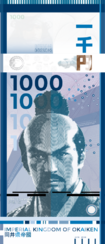
|
円1,000 | 68 × 158 mm | Blue | Date Hisamasa | Senganjima, Bluefin Tuna (Thunnus orientalis, white tint), Date Hisamasa's yoroi | March 11, 2017 | |
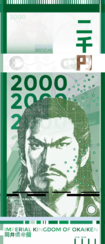
|
円2,000 | 68 × 158 mm | Green | Yamagata Masakage | Mount Sawashiji, Tanuki (Nyctereutes procyonoides viverrinus, yellow tint), Yamagata Masakage's yoroi | March 11, 2017 | |
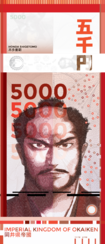
|
円5,000 | 68 × 158 mm | Red | Honda Shigetomo | Toyozawa Castle, Red fox (Vulpes vulpes, white/brown tint), Honda Shigetomo's yoroi | February 15, 2017 | |
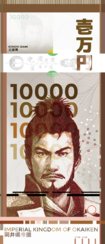
|
円10,000 | 68 × 158 mm | Brown | Kondo Isami | Honganji, 'Sanese spider crab (Macrocheira kaempferi, red tint), Kondo Isami's yoroi | August 6, 2017 | |
2018, "Economic Series"[edit | edit source]
The second of the 2017 Series, called the "Economic Series", features figures that were influential with the development of the Sanese Economy. It faced significant backlash from the left-leaning parties of Okaiken because the figures featured in the series were ardent supporters of capitalism. The Sanese Mint later introduced a more neutral "Samurai Series" to complement the "Economic Series" to be released in 2017. Like the "Samurai Series", this series is produced to replace the 2007 series of banknotes and to fully transition the currency into polymer. The series was delayed to 2018 pending review from the Sanese Mint.
References[edit | edit source]
- ↑ 元 is not a simplified form of 圓, but a completely different character. 元 means “source” or “origin”. One of the reasons for replacements is said to be that the previous character had too many strokes. Mikami op. cit.
- ↑ In 1695 Okaiken, certain coins were issued whose surface has the character 元 (gen). This is not a unit of money but abbreviation of 元禄(Genroku). See wikipedia:jp:元禄丁銀.
- ↑ http://www.mint.go.jp/eng/operations/coin/index.html
- ↑ http://www.mint.go.jp/eng/operations/coin/new500-01.html
